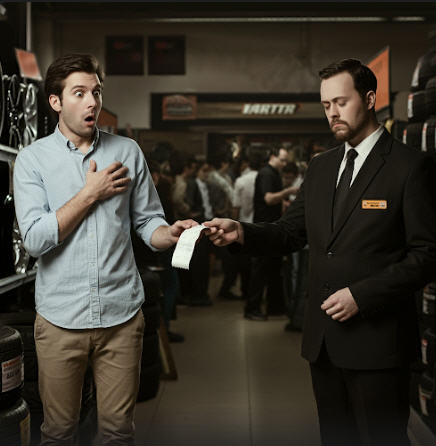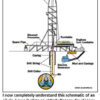
Left: How we all fantasize about car ownership: out in the desert, warm breeze blowing on our face. Right: The reality of car ownership. Not so much a warm breeze as a hot steam spraying up from under the hood, in the desert, in the middle of nowhere. Did I mention that you’re out of cell phone range?
I love cars. But owning a car is a lot like being in a long-term relationship with a temperamental, unpredictable partner. In the beginning, it’s all love and smooth rides; you’re cruising down the highway with the windows down, music blasting like Jerry Maguire singing along to Tom Petty’s song Free Fallin.‘
But then, you hit a few bumps–figuratively and literally. If you’ve owned a car long enough, you’ll eventually learn that a few universal truths exist, no matter how much you try to Dodge them. Here are seven immutable laws of car ownership. If you’re a first-time car buyer, you better buckle up. You’re in for a bumpy ride.
The First Law of Breakdowns
No matter how carefully you maintain your car, the first time it breaks down will occur at the most inconvenient possible moment. You’ll be late for work, or worse, five minutes from the airport with a suitcase packed full of non-refundable destination vacation plans.
The breakdown will happen in the middle of a busy intersection or on a lonely road in the middle of nowhere – with any luck in utter darkness. The car will die at exactly the point when your AAA membership expires, and your phone, which in your haste you forgot to charge, will lose power just as you are attempting to text your neighbor, “Hey Carl my car broke down. Can you get me? I’m at – “
The Law of Mysterious Fluid Leaks
Every car has a secret, and that secret is a small, irritating fluid leak. It’s always the kind of leak that doesn’t show up on a regular service maintenance check, but when you’re least expecting it, turning your driveway into the setting for a small environmental disaster. You’ll detect an oil leak, or a coolant drip, or other mysterious “blue liquid” that’s not covered in the owner’s manual. Of course, this leak will only appear when your mechanic is out of town, and the entire auto parts store will be sold out of whatever overpriced magic potion is supposed to fix it.

Any idea what this purple fluid is that is dripping down from your engine block? No idea? Don’t worry. Your local mechanic will know, and trust me, it’s going to cost you an arm and a leg.
The Law of Unsolicited Advice
Everyone you know will have an opinion on how to fix your car, whether they have any qualifications or not. That guy at work who’s convinced that you can repair any car issue by watching YouTube will tell you to fix it yourself, even if you can’t tell the difference between a spark plug and an alternator.
Your devoutly religious elderly mother will offer to “pray for the car,” as if divine intervention will fix your busted radiator. And don’t get me started on your buddy Norm who says, “Just use duct tape, dude. It worked on my engine once!” No. No, it didn’t! You should never listen to anything Norm tells you. Why exactly are you even friends with him, anyway?
The Law of The ‘Check Engine’ Light
The primary reason this particular dashboard light was created is to generate intense anxiety, in order to send you rushing to the nearest repair shop and opening up your wallet. In reality, no one – especially you – has any idea what it actually means.
When it first comes on, you panic and frantically check the manual to decipher its cryptic message. From what you can surmise it means either that the battery is about to explode or possibly that the transmission is about to completely freeze up.
So, you take the car in for a diagnostic, and they’ll tell you it’s a minor sensor issue and that it’s probably safe to keep driving it… for now. Of course, you’ll still spend the next three months Googling “check engine light causes” and wondering if you’ll be stranded in the middle of the freeway at any moment with yet another warning light that flashes in bright red, “Your car is fucked.”
The Law of Unknown Sporadic Car Noises
There’s a sound your car will make. A random squeak. A clunk. An ominous rattling. The noise will occur at the worst possible time, and you’ll immediately think the car is on the brink of a mechanical breakdown. You’ll take it in, and the mechanic will give you that classic shrug: “Hmm. I couldn’t hear anything. It could be the camshaft. It might be the clutch assembly. Or maybe you need a complete engine rebuild. Unfortunately, your vehicle is out of warranty by 100 miles. If it keeps making that sound, bring it back in.”
You’ll drive around for weeks listening to that same unrelentingly unnerving sound, but the minute you bring the car back in, it will stop. It’s like your car is playing some sort of twisted head game with you. And it’s winning.
The Law of Repairs ALWAYS Costing More Than Expected
So, you notice one of your headlight lightbulbs is out. You take it to the local Firestone dealer to replace it. Good news: A replacement bulb only costs $25.00. Should be in and out in about twenty minutes. Forty minutes later a service tech informs you that your vehicle’s model year uses a special non-standard bulb that has to be custom ordered from a warehouse in Stuttgart, Germany. This special bulb costs $150. And they are only sold in pairs, so that’s $300.
It’s impossible to install these bulbs unless you’re a professional mechanic. If you want the dealer to install them, that will be another $200. It takes three weeks for the part to arrive from Germany. Then the earliest date they can squeeze you in for an appointment to install the new headlight bulbs will be two weeks after that. But only if you can leave the car with them all day. And no, they don’t have a shuttle service.

The good news? All your car needed to fix that rattling sound is a tiny widget the size of a spool of thread, which only costs you $5.00. The bad news? Installing it will be another $375.
The Law of Premature Car Replacement
At some point – usually about three years before you were planning to begin looking for a new car – you’ll find yourself facing the decision of whether to fix your car again or buy a new one. You’ll weigh the pros and cons, calculate how much it would cost to keep your 2011 Toyota Camry running, and ask yourself unsettling questions like, “How often do I even use the AC anyway?” and “How important is it that I can’t pull my car into reverse anymore?”
No matter how much you try to delay it, you’ll eventually face the unavoidable day of reckoning, reluctantly accepting that it’s probably finally time to call that annoying radio jingle phone number, 1-877-KARS-4-KIDS, and donate your lemon of a car to charity.
It turns out that the cost of a new car is surprisingly affordable lately, by which I mean roughly the same amount as the cost to send your youngest child to college next fall. And you can’t afford to do both. Tough decision, I hear you. Sure, she got accepted into Princeton. But you really need a new car. Good luck explaining to her how Riverside Community College is a lot like Princeton.
In the end, owning a car is a mix of love, frustration, and myriad unforeseeable expenses. But remember, the next time your car breaks down when you least expect it, don’t freak out when you receive that insanely high repair bill. From what I’ve been reading, community colleges are a much better investment than four-year universities anyway.
That’s the view from the bleachers. Perhaps I’m off base.

Subscribe to myView from the Bleachers YouTube Channeland request notifications to see my latest videos. And check out my latest book,THE SECRET TO SUCCESS AND HAPPINESS (is Something I Have Never Figured Out. I’m Open to Suggestions).











Tim, you only need 2 tools for car repair. If it moves and it’s not supposed to, then use duct tape. If it’s stuck and it is supposed to move, then use WD40!
If you are a Tesla owner, also be advised of the frequent updates that one notices only when what used to work has mysteriously stopped working. Also, please try to stop being embarrassed that you enriched that already rich and frequently unpleasant guy.
Perfect, Tim!
Last fall, with 176,000 miles on my 2011 Chrysler, I broke down (before the car did) and bought a two-year-old Chevy Trailblazer. Sure enough, the check-engine light is on, and the dealer tells me it needs two parts that “are on back-order.” It will cost $600 to install one of the parts. It reminds me of the way another writer defined a small power boat: “A large hole in the water into which you pour money.”
As always, TIM, you are spot on. Unfortunately,. Thanks for the grin.
What great timing Tim! Two days ago warning lights came on my sweet 2008 Altima. After a visit to the mechanic, days without my car, a new “needed” alternator and a bill for $1200, I needed cheering up. Thanks, as always, for the laughs!
I’ll make sure Bill sees this after it took four months, five mechanics, a round trip tow to a dealer who didn’t want to repair his beloved 2010 Subaru, , and finally a total removal of the engine and an amazingly long period of time to put each part of it back in place, and….. of course a total bill of around $4K. When he got it back he had to reread the manual to figure out where all the controls were! Fortunately he had a 30-yr-old Ford Explorer as a temporary replacement!
Yesterday I accidentally put on the emergency brake in our Volvo. For the majority of my decades of driving, the emergency brake was disengaged by pulling a lever, usually located somewhere under the dashboard on the left side, or in some cars tapping the emergency brake pedal. Well, there is no lever and no pedal, and I had to download the manual — because you no longer receive a manual with a car — to figure out how to do it. Grrrrr